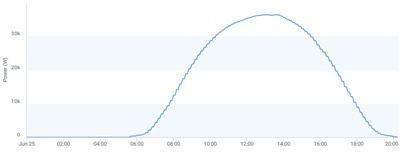Welcome to the
Run on Sun Monthly Newsletter

In this Issue: |
June, 2017
Volume: 8 Issue: 6
Solar Boom Devolves to Power "Glut"The LA Times today is out with an article titled, "Energy goes to waste as state power glut grows". The article describes how as solar power has grown dramatically in the Golden State, it has lead to a problem that has caused the state to actually pay neighboring Arizona to take our surplus energy! Meanwhile the IOUs are badgering the CPUC to allow them to spend billions on additional natural-gas-fired power plants! This is crazy town, and points to the need to radically redesign the incentives provided to utilities in the state. Here's our take...
The perverse incentive here is that the IOUs - SCE, PG&E, and SDG&E - earn their money by building stuff, whether that stuff is used or not. So it would seem that the trick here is to get them to build The Right Stuff, which certainly isn't another natural gas peaker plant. Instead, the clear winner here should be storage, particularly storage at utility scale. Bring enough intelligent storage into the mix and goodbye "Duck Curve" and hello a fossil-fuel-free future. The CPUC should be providing the same rate-making incentive to build vast amounts of storage, even if at a premium price, rather than non-renewable generation capacity. No renewable facility should ever have its output curtailed (as has happened 31% of the time in the first few months of this year), and no renewable energy should ever be exported to a neighboring state, except when such an export serves the economic interest of California ratepayers. California is going to get to 100% renewables, we have to, as does the world. We can and should show the way, but we will need to change the way utilities approach the problem if we are to get there anytime soon. |
“This is Madness - but we can fix this…”
Help Us Spread the News!


From 'Glut' to Glory - Making Storage Work! ACTION NEEDED!Earlier this month we wrote about a growing problem in California: as we have increased the role of solar generation in our electric mix, we have found ourselves in the awkward position of having to occasionally curtail that production, or worse yet, pay neighboring states like Arizona to take our excess! This is clearly not sustainable, but fortunately there is a fix in the works in the form of Senate Bill 700, and it just needs the support of the solar community to make it happen. Here's our take... The Glut
Of course, there is such a way. It is called energy storage. Storage could provide that time-shift needed to make the most of our abundant solar energy. So why aren't we using it? In a word - cost. Today, energy storage systems are just too expensive, and the existing rebate system for storage systems, known as SGIP, is a joke. The SGIP process, which is essentially a lottery, is no way to run a rebate program. As we have argued in the past, for a rebate program to be meaningful, it has to be stable and predictable. SGIP is neither. The GloryBut this isn't rocket science, and we have a relevant case study right before us - the California Solar Initiative (CSI) rebate program. When CSI began, back in 2007, its 10-year mission was to dramatically grow the PV market in California and, in so doing, drive down the costs of solar. Back when it began, Run on Sun was installing systems for $8.47/Watt. By 2014, after CSI ran its course, our install price was down to $4.13/Watt - a reduction of 52% in just seven years! CSI (along with the muni-rebate programs) helped to achieve that cost reduction by providing transparency and predictability that a lottery program cannot replicate. Moreover, the CSI program was easy for even the smallest contractors to navigate, making the program available to all. This is what is needed to bring storage prices down, drive exponential growth (and the local jobs that go with that growth), and stop the madness induced by our present power glut. So how do we get there, if SGIP is not the way? Glad you asked - enter SB 700 (Weiner, D-San Francisco), the Energy Storage Initiative (ESI) that would create a 10-year, $1.4 Billion rebate program along the lines of CSI, but for energy storage systems. Here's how CALSEIA describes the bill:
The bill has already passed the California Senate (sadly, on a straight party-line vote), but it faces an important vote as early as July 5th in the Assembly Utilities and Energy Committee, Chaired by Pasadena's own, Chris Holden. This bill should have bi-partisan support given the urgent need to move to an all-renewables future, but for that to happen, Committee members (and the Assembly as a whole) need to hear from their constituents. If you are in Chairman Holden's district (which includes all of Pasadena and Altadena) you can reach his office at: 916-319-2041 and urge him to support SB700. Otherwise, you can find out your member of the Assembly by doing a search using this form here. Together we can get this bill over the hump - watch this space! |
And while you are at it…Ask your Senator to vote YES on SB 366!From our friends at Vote Solar: The communities that bear the biggest burden of energy inequity and fossil fuel pollution are often the same communities that face financial and physical barriers to participating in solar and its benefits: lower utility bills, clean air and local jobs. SB 366 is designed to change that. The Renewable Energy for All Bill, Senator Connie Leyva’s SB 366, has a strong environmental justice focus and aims to improve existing solar programs by ensuring that they financially benefit low-income customers. The bill was recently approved by two key committees. Take action to get it through the Senate! Here's the link to find your Senator. Have a great 4th of July holiday! |

